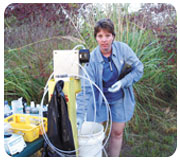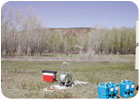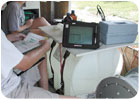
Collecting water samples from a multi-level monitoring well.
Low-stress purging and sampling results in collection of ground water samples from monitoring wells that are representative of ground water conditions in the geological formation. This is accomplished by minimizing stress on the geological formation and minimizing disturbance of sediment that has collected in the well. The procedure applies to monitoring wells that have an inner casing with a diameter of 2 inches or greater, and maximum screened intervals of 10 feet unless multiple intervals are sampled. The procedure is appropriate for collection of ground water samples that will be analyzed for volatile and semi-volatile organic compounds (VOCs and SVOCs), pesticides, polychlorinated biphenyls (PCBs), metals, and microbiological and other contaminants. This procedure does not address the collection of light or dense non-aqueous phase liquids (LNAPL or DNAPL) samples, and should be used for aqueous samples only.
The purpose of the low-stress purging and sampling procedure is to collect ground water samples from monitoring wells that are representative of ground water conditions in the geological formation. This is accomplished by setting the intake velocity of the sampling pump to a flow rate that limits drawdown inside the well casing.
Sampling at the prescribed (low) flow rate has three primary benefits. First, it minimizes disturbance of sediment in the bottom of the well, thereby producing a sample with low turbidity (i.e., low concentration of suspended particles). Typically, this saves time and analytical costs by eliminating the need for collecting and analyzing an additional filtered sample from the same well. Second, this procedure minimizes aeration of the ground water during sample collection, which improves the sample quality for VOC analysis. Third, in most cases, the procedure significantly reduces the volume of ground water purged from a well and the costs associated with its proper treatment and disposal.

Ground water sampling near Gunnison, Colo.
Potential Problems
Problems that may be encountered using this technique:- difficulty in sampling wells with insufficient yield
- failure of one or more key indicator parameters to stabilize
- cascading of water and/or formation of air bubbles in the tubing
- cross-contamination between wells
Insufficient yield– Wells with insufficient yield (i.e., low recharge rate of the well) may dewater during purging. Care should be taken to avoid loss of pressure in the tubing line due to dewatering of the well below the level of the pump’s intake. Purging should be interrupted before the water level in the well drops below the top of the pump, as this may induce cascading of the sand pack. Pumping the well dry should therefore be avoided to the extent possible in all cases. Sampling should commence as soon as the volume in the well has recovered sufficiently to allow collection of samples. Alternatively, ground water samples may be obtained with techniques designed for the unsaturated zone, such as lysimeters.
Failure to stabilize– If one or more key indicator parameters fails to stabilize after four hours, one of four options should be considered: a) continue purging in an attempt to achieve stabilization; b) discontinue purging, do not collect samples, and document attempts to reach stabilization in the log book; c) discontinue purging, collect samples and document attempts to reach stabilization in the log book; or d) secure the well, purge and collect samples the next day (preferred). The key indicator parameter for samples to be analyzed for VOCs is dissolved oxygen. The key indicator parameter for all other samples is turbidity.
Cascading – To prevent cascading and/or air bubble formation in the tubing, care should be taken to ensure that the flow rate is sufficient to maintain pump suction. Minimize the length and diameter of tubing (i.e., 1⁄4- or 3⁄8-inch I.D.) to ensure that the tubing remains filled with ground water during sampling.
Cross-contamination– To prevent cross-contamination between wells, it is strongly recommended that dedicated, in-place pumps be used. As an alternative, the potential for cross-contamination can be reduced by performing the more thorough daily decontamination procedures between sampling of each well in addition to the start of each sampling day.
Also, adequate equipment should be on-hand so that equipment failures do not adversely impact sampling activities.

Proper equipment decontamination is important.
Sampling Procedures
- Start at the well known or believed to have the least contaminated ground water and proceed systematically to the well with the most contaminated ground water. Check the well, the lock and the locking cap for damage or evidence of tampering. Record observations.
- Lay out a sheet of polyethylene for placement of monitoring and sampling equipment.
- Measure VOCs at the rim of the unopened well with a photo ionization detector (PID) and a flame ionization detector (FID) instrument and record the reading in the field log book.
- Remove the well cap.
- Measure VOCs at the rim of the opened well with a PID and an FID instrument and record the reading in the field log book.
- If the well casing does not have a reference point (usually a V-cut or indelible mark in the well casing), make one. Note that the reference point should be surveyed for correction of ground water elevations to the mean geodesic datum.
- Measure and record the depth to water (to 0.01 ft.) in all wells to be sampled prior to purging. Care should be taken to minimize disturbance in the water column and dislodging of any particulate matter attached to the sides or settled at the bottom of the well.
- If desired, measure and record the depth of any NAPLs using an interface probe. Care should be taken to minimize disturbance of any sediment that has accumulated at the bottom of the well. Record the observations in the log book. If LNAPLs and/or DNAPLs are detected, install the pump at this time. Allow the well to sit for several days between the measurement or sampling of any DNAPLs and the low-stress purging and sampling of the ground water.
- Slowly lower the pump, safety cable, tubing and electrical lines into the well to the depth specified for that well. The pump intake must be kept at least 2 feet above the bottom of the well to prevent disturbance and resuspension of any sediment or NAPL present in the bottom of the well. Record the depth to which the pump is lowered.
- Before starting the pump, measure the water level again with the pump in the well. Leave the water-level measuring device in the well.
- Start pumping the well at approximately 16 ounces per minute. The water level should be monitored approximately every five minutes. Ideally, a steady flow rate should be maintained that results in a stabilized water level (drawdown of 0.3 ft. or less). Pumping rates should, if needed, be reduced to the minimum capabilities of the pump to ensure stabilization of the water level. Care should be taken to maintain pump suction and to avoid entrainment of air in the tubing. Record each adjustment made to the pumping rate and the water level measured immediately after each adjustment.
- During purging of the well, monitor and record the field indicator parameters approximately every five minutes. The well is considered stabilized and ready for sample collection when the indicator parameters have stabilized for three consecutive readings. Dissolved oxygen and turbidity usually require the longest time to achieve stabilization. The pump must not be removed from the well between purging and sampling.
- Collect samples at a flow rate between 4 ounces and 8 ounces per minute and such that drawdown of the water level within the well does not exceed the maximum allowable drawdown of 0.3 ft. VOC samples must be collected first and placed directly into sample containers. All sample containers should be filled with minimal turbulence by allowing the ground water to flow from the tubing gently down the inside of the container. Ground water samples to be analyzed for VOCs may require pH adjustment. If pH adjustment is necessary for VOC sample preservation, the amount of acid to be added to each sample vial prior to sampling should be determined, drop by drop, on a separate and equal volume of water. Ground water purged from the well prior to sampling can be used for this purpose.
- After collection of the samples, the tubing, unless permanently installed, must be properly discarded or dedicated to the well for resampling by hanging the tubing inside the well.
- Measure and record well depth.
- Close and lock the well.
Quality Control Samples
Quality control samples must be collected to determine if sample collection and handling procedures have adversely affected the quality of the ground water samples. All field quality control samples must be prepared exactly as regular investigation samples with regard to sample volume, containers and preservation. As previously noted, ground water samples should be collected systematically from wells with the lowest level of contamination through to wells with highest level of contamination.
A mobile lab and digital probes are utilized to monitor and record field parameters during a well purge. Field parameters must stabilize prior to sample collection.
Decontamination
Non-disposable sampling equipment, including the pump and support cable and electrical wires which contact the sample, must be decontaminated thoroughly each day before use and after each well is sampled. Dedicated, in-place pumps and tubing must be decontaminated thoroughly prior to their initial use. For centrifugal pumps, it is strongly recommended that non-disposable sampling equipment – including the pump and support cable and electrical wires in contact with the sample – be decontaminated thoroughly each day before use. EPA’s field experience indicates that the life of centrifugal pumps may be extended by removing entrained grit. This also permits inspection and replacement of the cooling water in centrifugal pumps. All non-dedicated sampling equipment (pumps, tubing, etc.) must be decontaminated after each well is sampled.The recommended daily decontamination procedures:
- Pre-rinse: Operate pump in a deep basin containing 8 gallons to 10 gallons of potable water for five minutes, and flush other equipment with potable water for five minutes.
- Wash: Operate pump in a deep basin containing 8 gallons to 10 gallons of a non-phosphate detergent solution, such as Alconox, for five minutes, and flush other equipment with fresh detergent solution for five minutes. Use the detergent sparingly.
- Rinse: Operate pump in a deep basin of potable water for five minutes, and flush other equipment with potable water for five minutes.
- Disassemble pump.
- Wash pump parts: Place the disassembled parts of the pump into a deep basin containing 8 gallons to 10 gallons of non-phosphate detergent solution. Scrub all pump parts with a test tube brush.
- Rinse pump parts with potable water.
- Rinse the inlet screen, the shaft, the suction interconnector, the motor lead assembly and the stator housing, with distilled/deionized water.
- Place the impeller assembly in a large glass beaker and rinse with 1-percent nitric acid.
- Rinse the impeller assembly with potable water.
- Place the impeller assembly in a large glass bleaker and rinse with isopropanol.
- Rinse the impeller assembly with distilled/deionized water.
When conducting a between-well decontamination operation:
- Pre-rinse: Operate pump in a deep basin containing 8 gallons to 10 gallons of potable water for five minutes, and flush other equipment with potable water for five minutes.
- Wash: Operate pump in a deep basin containing 8 gallons to 10 gallons of a non-phosphate detergent solution, such as Alconox, for five minutes, and flush other equipment with fresh detergent solution for five minutes. Use the detergent sparingly.
- Rinse: Operate pump in a deep basin of potable water for five minutes and flush other equipment with potable water for five minutes.
- Final Rinse: Operate pump in a deep basin of distilled/deionized water to pump out 1 gallon to 2 gallons of this final rinse water.

A complete and accurate field log book is vital to proper sampling of monitor wells.
Field Log Book
A field log book should be kept each time ground water monitoring activities are conducted in the field. The field log book should document:- well identification number and physical condition,
- well depth and measurement technique,
- static water level depth, date, time and measurement technique,
- presence and thickness of immiscible liquid layers and detection method,
- collection method for immiscible liquid layers,
- pumping rate, drawdown, indicator parameters values and clock time, at three minute to five minute intervals; calculate or measure total volume pumped,
- well sampling sequence and time of sample collection,
- types of sample bottles used and sample identification numbers,
- preservatives used,
- parameters requested for analysis,
- field observations of sampling event,
- name(s) of sample collector(s),
- weather conditions,
- quality assurance/quality control data for field instruments.
This article is provided through the courtesy of the U.S. Environmental Protection Agency.
Report Abusive Comment